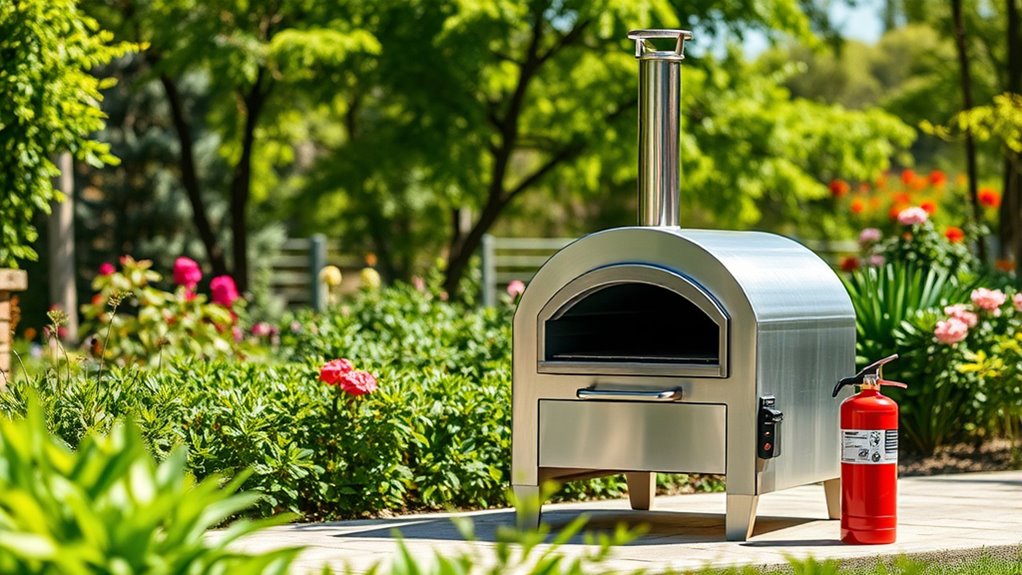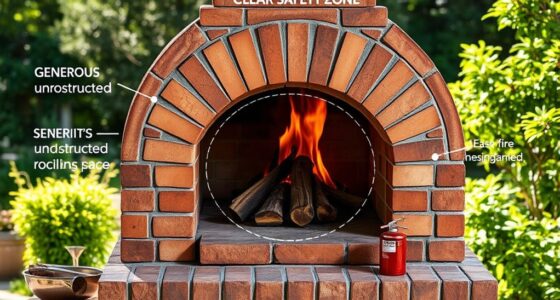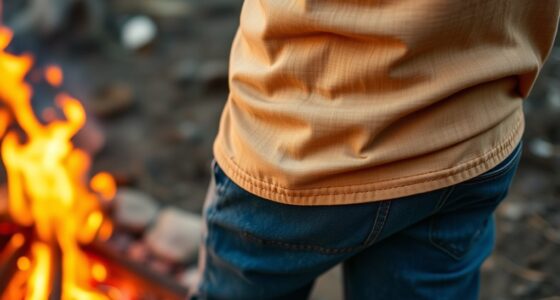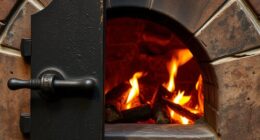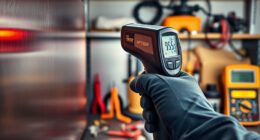Outdoor-use only ovens are built to meet strict safety standards and certifications that guarantee they operate safely in outdoor environments. These certifications confirm the oven is designed to handle elements like rain, wind, and temperature changes without issues. It’s vital to keep these ovens outside because they’re tested to prevent hazards and ensure durability. Continuing to explore this topic will help you understand why certification and proper placement are so essential for safe outdoor cooking.
Key Takeaways
- Certification ensures outdoor ovens meet safety standards for heat resistance, electrical safety, and durability in open environments.
- Labels from agencies like UL or CSA confirm the oven has passed rigorous safety evaluations suitable for outdoor use.
- Proper installation and use, as recommended during certification, prevent hazards caused by weather, wind, or improper setup.
- Certified outdoor ovens are designed to withstand outdoor elements, reducing risks like electrical faults or structural damage.
- Following certification guidelines helps maintain safety, reliability, and compliance when using outdoor-use only ovens outside.
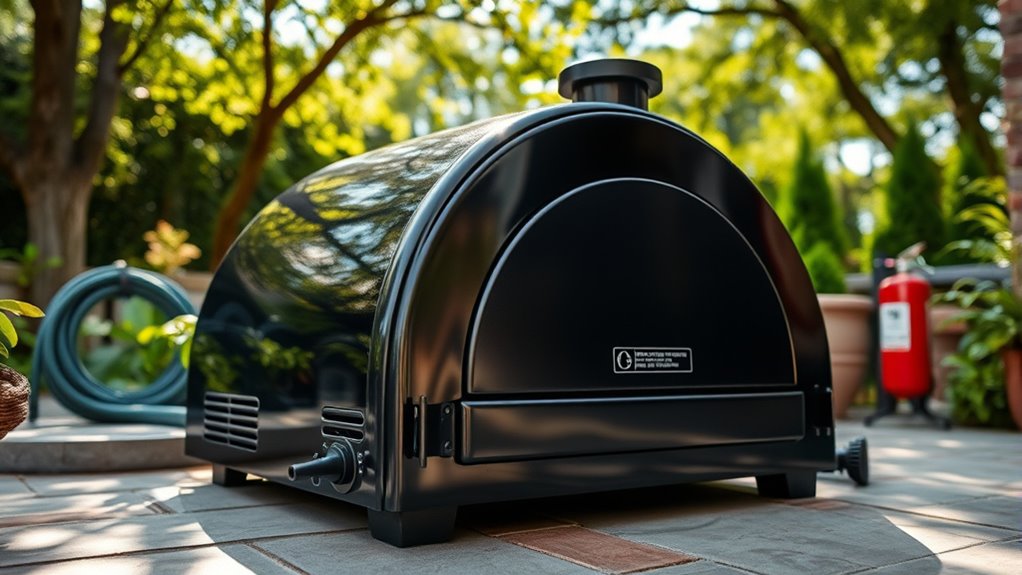
Certification is a formal process that verifies your skills, knowledge, or qualifications in a specific area. When it comes to outdoor-use only ovens, understanding the certification process is crucial for ensuring safety and compliance. These appliances are designed with unique safety standards that are different from indoor models, and knowing how to navigate certification processes helps you make informed decisions and prevents potential hazards.
Outdoor-use ovens must meet strict safety standards set by regulatory agencies to ensure they operate safely in open environments. These standards cover aspects like heat resistance, electrical safety, and proper venting, all of which are essential to prevent accidents. As a consumer, you should look for certification markings from reputable organizations, such as UL (Underwriters Laboratories) or CSA (Canadian Standards Association). These marks indicate that the oven has undergone rigorous testing and adheres to established safety standards, giving you confidence that the appliance is safe for outdoor use.
Outdoor ovens must meet safety standards like UL or CSA for safe outdoor operation.
The certification process involves thorough testing of the oven’s components and overall design. Manufacturers submit their products for evaluation, demonstrating that they meet all safety standards. During this process, the appliances are subjected to various tests, such as temperature control, electrical safety checks, and durability assessments. Once approved, they receive certification labels, which you should verify before purchasing. These labels confirm that the product is compliant with safety standards and has passed all necessary certification processes.
It’s essential to understand that outdoor-use only ovens aren’t just designed for durability—they’re also engineered with safety in mind. Certification processes ensure that these appliances can withstand outdoor elements like rain, wind, and temperature fluctuations without risking safety. Additionally, certification labels provide assurance that the product has been independently evaluated for safety and reliability. As a user, you should always follow the manufacturer’s instructions and adhere to the recommended placement guidelines. Proper installation and usage are vital components of maintaining the safety standards set during certification.
Frequently Asked Questions
Can Outdoor-Use Ovens Be Safely Used Indoors in Emergencies?
No, outdoor-use ovens shouldn’t be used indoors, even during emergencies. Doing so risks indoor safety because these ovens aren’t designed for enclosed spaces and can produce dangerous carbon monoxide. For emergency preparedness, always have a safe, certified alternative like a portable stove or grill suitable for indoor use. Prioritize safety by following manufacturer guidelines and never compromise indoor safety by using outdoor-only equipment inside.
What Are the Health Risks of Indoor Use of Outdoor-Only Ovens?
Using outdoor-only ovens indoors poses serious health risks, even if you think ventilation is sufficient. You risk dangerous carbon monoxide buildup, which can cause headaches, dizziness, or worse. Proper indoor ventilation isn’t designed for these appliances, so you can’t safely prevent these risks. Always keep outdoor-use only ovens outside to prevent carbon monoxide poisoning and maintain safe air quality inside your home.
Are There Any Portable Outdoor Ovens Suitable for Indoor Use?
There are no portable outdoor ovens specifically designed for indoor safety. Most outdoor-only ovens lack proper ventilation and safety features needed indoors, making them unsafe for indoor use. To guarantee safety, stick with portable alternatives approved for indoor cooking, like countertop convection ovens or electric grills. These options provide the convenience you want while maintaining proper safety standards, preventing risks like fire or carbon monoxide poisoning.
How Do Outdoor Oven Certifications Differ Internationally?
International standards for outdoor oven certifications vary, so you should check specific certification differences depending on the country. For example, UL certification in the US emphasizes safety and electrical standards, while CE marking in Europe focuses on conformity with health, safety, and environmental requirements. These differences impact how outdoor ovens are tested and approved, making certain they meet local safety regulations. Always verify the certification to ensure your oven complies with regional standards.
Can Outdoor-Use Ovens Be Modified for Indoor Safety Compliance?
No, outdoor-use ovens shouldn’t be modified for indoor safety compliance because safety modifications often compromise certification requirements. These ovens are designed specifically for outdoor environments, and altering them can create fire hazards, ventilation issues, and carbon monoxide risks. Instead, follow the manufacturer’s guidelines and ensure proper outdoor setup. Attempting to modify an outdoor oven for indoor use can void warranties and pose serious safety concerns.
Conclusion
So, next time you see an outdoor-only oven, remember it’s not just a fancy gadget, but a certified rebel refusing to mingle indoors. It’s like the celebrity of the backyard, demanding its own stage. Keep it outside, let it bask in the sun, and avoid turning your living room into a smoky disaster zone. After all, some appliances just want to keep their wild side alive—inside, they’d never make the cut!
